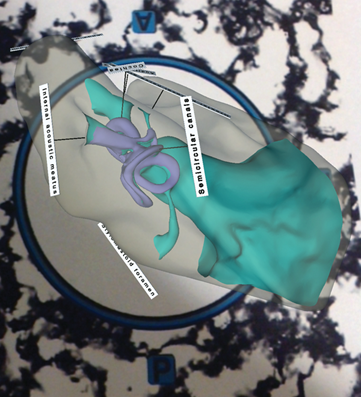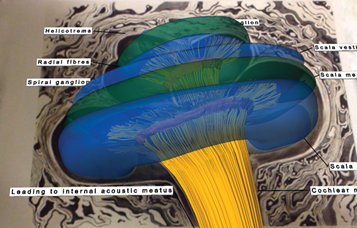www.andreazariwny.com
Augmented reality (AR), which aims to enhance our perceptions (visual and otherwise) using computer-generated information, is not a new concept. However, the widespread use of smartphone technology has quickly lead to the development of countless apps that use AR. The use of AR for educational purposes is one of the more exciting applications of the technology.
For students and professionals tasked with understanding inner-ear anatomy, trying to visualise the negative space within the petrous temporal bone and inner ear can be a formidable challenge. The InvisibleEar™App (for iPhone/iPad, $2.99 USD from Apple App Store) allows users to do just that.
To develop InvisibleEar, visual communicator Andréa Zariwny used images from CT scans to produce anatomically accurate 3D models of petrous temporal bone anatomy. When the user hovers the iPhone/iPad camera above one of several free downloadable glyphs (or physical models that can be purchased through the app, $125-850 USD), the negative spaces within the petrous temporal bone becomes visible. The glyphs and the models can then be rotated in order to view the structures at various angles.

Within the app, there are a number of buttons that can be used to toggle between the available views. For example, users can show/hide the negative space of both the petrous temporal bone and the inner ear, as well as labels for various structures of interest. As well, users can adjust the opacity of the petrous bone. The glyph for the cochlea provides users with a stunning 3D representation of cochlear anatomy, complete with options to show or hide inner ear fluids (endolymph and/or perilymph).
A demo video, available on the app’s website (www.andreazariwny.com), shows how these glyphs might be incorporated into future textbooks as a helpful learning tool. In it, the 3D representation of the cochlea is superimposed over the traditional textbook illustration. For anyone who has struggled to make sense of the two-dimensional images provided in a textbook, these glyphs would undoubtedly be a welcome addition.
InvisibleEar is worth a look for anyone hoping to learn inner ear anatomy, though the app will likely find the majority of its audience in hearing healthcare professionals and medical students.




